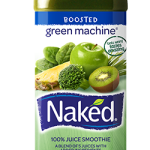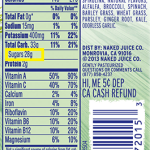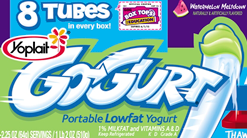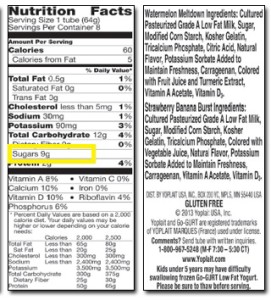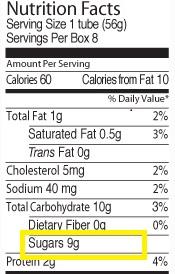A Tricky Question
As I began to research for this article, I expected to find an easy response to, “How much sugar should we eat per day?” However, I ended up on a lengthy goose chase to get a straightforward answer.
So, in this post I bring you the complicated nature of sugar consumption, especially in America, and explain how the Food and Drug Administration is vague when it comes to sugar standards.
First, let’s talk about some recent research findings on sugar, and then explore why it is so difficult to figure out how much we should be eating. Last, I will provide you with an actual suggested daily value, along with some examples to give you an idea how much sugar you may be consuming today.
The Research Says: Sugar is Bad For You
This shouldn’t be too surprising, but let’s look at some study results to see exactly why it’s so bad for us:
- Between 2003-2006, 16,822 people responded to the National Health and Nutrition Examination Survey, which found that, “foods categorized as desserts, snacks, or beverages, contribute 13.6% of total calories, 83% of added sugar intake, and provide little or no nutritional value.” (2013)
- Higher sugar intake is related to increased risk for cardiovascular disease mortality (death by heart disease) (2015)
- Higher rates of sugar intake can lead to cognitive (brain) dysfunction (2014)
- Similar to addictive drugs, sugar withdrawals lead to increases in impulsive behavior (2015)
- Between 1980 and 2009, body mass index and added-sugar intake simultaneously increased in American men and women ages 25-74 (2013)
- Increased soda consumption was related to higher depressive symptoms in adults in China (2015)
FDA and AHA: Unclear Standards
The Food and Drug Administration (FDA) recently proposed a revision to food labels to make them easier to read and more understandable to consumers.
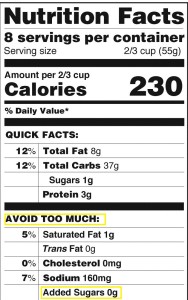 Of particular interest to this post is the addition of ‘added sugars’ to all food labels. This should be good, right? Well, it’s a good start, but it still leaves room for improvement.
Of particular interest to this post is the addition of ‘added sugars’ to all food labels. This should be good, right? Well, it’s a good start, but it still leaves room for improvement.
For instance, have you ever noticed that compared to most other ingredients, sugar does not have a % daily value? This is because when it comes to a set limit on added sugar intake levels, the FDA states, “the government has no specific recommendation for added sugars.”
So, now you see my first dilemma in answering my simple question. It’s great that we will now be able to see how many grams of added sugar are in our food, but what good does that do if we have nothing to compare it to?
Next stop, the American Heart Association (AHA). What I found here was a breakdown of calories from added sugars per serving. For instance, a 12 oz. can of soda contains 132.5 calories from added sugars. The AHA also recommends that American women consume no more than 100 sugar-based calories per day and American men no more than 150 sugar-based calories per day.
While this does technically answer our question about how much sugar we should eat per day, I’m still not satisfied because there is just way too much math that is required to get to a meaningful answer. For example, the AHA states that their calorie information is not compatible with the information on a food label, but goes on to explain that there are 4 calories per 1 gram of sugar, so all you need to do is multiply the grams of sugar on a nutrition label by 4 to get the total sugar-based calories.
…I’m having flashbacks to Mr. Parsek’s 8th grade algebra word problems….
Confused yet? I was too. I was also a bit concerned; if there is so much scientific evidence that sugar is bad for us, then why don’t we have a recommended daily value? And why is it so difficult to figure out how much we should be eating?
The only answer I come to is that they don’t want us to know how much sugar we are consuming, but let’s not get off course into another government conspiracy theory. We have a questions to answer!
Finally, an answer from the WHO
No, not the band silly, the World Health Organization (WHO). Since I was getting nowhere with American organizations, I expanded my search to overseas. According to the 2015 guideline for adult and children’s sugar intake, the WHO strongly recommends both adults and children reduce sugar to less than 10% of total calories consumed, but further encourages a reduction to only 5% of total caloric intake. Drum roll please! And 5% equates to 25 grams of sugar (6 teaspoons) per day.
That’s it! You should try to restrict your added sugar to approximately 25 grams/day.
Tougher Than You Might Think
To finish up, let’s look at a couple “healthy” food options that you might want to bypass the next time you are at the store based on their sugar levels.
Naked Green Machine
One serving (i.e. 8 oz., or half the bottle) contains 28 grams of sugar – more sugar than is recommended for the entire day!
Yoplait Strawberry Banana Burst Go-Gurt
9 grams doesn’t seem too bad, but let’s do the math just to be sure.
- 9g X 4 = 36 calories from sugar
- 36 ÷ 60 (the total calories) = .6, or 60%
- That means 60% of the total calorie intake from one tube of Go-Gurt is from sugar, while only 8% is from fat!
Trader Joe’s Organic Lowfat Yogurt Squishers
Surprisingly, this healthier yogurt alternative has the exact same number of calories and the same amount of sugar as their Go-Gurt competitor.
Lessons Learned
- Don’t be misled by “healthy” terms like “organic” or “low-fat”
- Check labels and do the math
- Try to limit your sugar intake to approximately 25 grams/day
Keep track of how much sugar you eat for the rest of the day and post it in the comments section below!
Forward this article to at least 3 friends or relatives who may be eating too much sugar.

